|
 Byssomerulius psittacinus Byssomerulius psittacinus
BiostatusPresent in region - Indigenous. Endemic
Images (click to enlarge)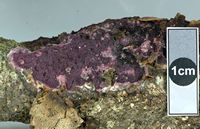
Owner: J.A. Cooper | 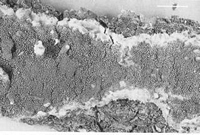
Caption: Fig. 3 Byssomerulius psittacinus. Habit. Scale bar= 5 mm. | 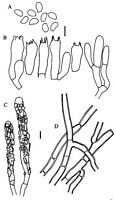
Caption: Fig. 4 Byssomerulius psittacinus. A, basidiospores; B, basidia; C, cystidioles; D,
generative hyphae. PDD 68255, holotype. Scale bars = 5 µm | 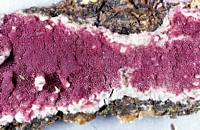
Caption: REB 1851, PDD71024, HB Bellbird S.R., 18/10/99
Owner: Ross Beever | 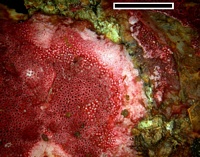
Caption: scale=5mm
Owner: J.A. Cooper | 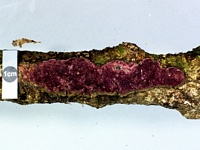
Owner: J.A. Cooper | 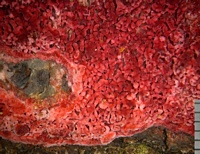
Owner: J.A. Cooper |
Article: Buchanan, P.K.; Ryvarden, L. (2000). New Zealand polypore fungi: six new species and a redetermination. New Zealand Journal of Botany 38(2): 251-263 (http://www.rsnz.org/publish/abstracts.php).
Description: Basidiocarps annual, resupinate, effused, to 15 x 4 cm, soft and fragile when fresh; pore
surface bright reddish purple (24.1.m.r P - 23.8.deep r P) when fresh, with margin
variable, to 1 mm across and undifferentiated in colour in mature parts or in young
specimens to 5 mm across and fading to white at edge, sometimes with greenish tinge;
pore surface changing on drying to a range of colours even within a single basidiocarp,
sometimes remaining reddish purple (24.5.gy.r P) in parts, also reddish orange (39.gy.r O
- 37.m.r O), brownish pink (33.br Pink), and pale orange-yellow (73.p.OY), brownish
orange (54.br O) in oldest herbarium specimens, no reaction with 3% KOH;
hymenophore when dry varying from distinctly poroid to reticulately poroid with broadly
rounded pore mouths, sometimes with irregularly arranged pits, in less mature parts pores
distinguished only as very shallow depressions; pores round to angular, 3-5 per mm; tube
layer up to 3 mm deep when fresh, shrinking and up to 1 mm deep when dry; subiculum
soft, floccose, white, up to 1.5 mm thick when dry though mostly thinner. Hyphal system
monomitic; generative hyphae with simple septa, sometimes slightly constricted at septa,
hyaline, with wall thin or thickened to 0.75 µm, 2.5-5 µm diam. in subhymenium, 3-6(-7.5) µm
in subiculum, moderately branched, more loosely arranged in subiculum than
subhymenium, mostly smooth in subiculum, sometimes covered with variable masses of
yellowish semicrystalline material in subhymenium and this same material covering
cystidioles. Cystidioles present particularly at pore mouths or on edges of folds where
they tend to dominate the hymenium, thin-walled, cylindrical to elongate- clavate,
covered in yellowish semicrystalline material, 25-65 x 5-8 µm. Basidia cylindrical to
clavate, 4-sterigmate, simple-septate at base, 14-22 x 4.5-6 µm, forming a continuous
layer amongst cystidioles at the pore mouth. Basidiospores ovoid to ellipsoid, adaxially
flattened, smooth and thin-walled, hyaline, IKI-, 4.3-5 x 2.5-3 µm. Causing a white rot of
wood.
Habitat: SUBSTRATA: Recorded only on Nothofagus species.
Distribution: New Zealand, widespread on both North and South Islands although
apparently uncommon.
Notes: ETYMOLOGY: psittacinus, parrot-like, referring to the wide variation of colour from
bright reddish purple when fresh to purple, brownish orange, pale orange, or pale yellow-orange when dry.
NOTES: B. psittacinus is readily recognisable in the field by its striking reddish purple
colour, the colour variously fading on drying, and the variable poroid to reticulately
poroid hymenophore. The species is described here in Byssomerulius Parmasto on
account of the hymenophore varying from regularly to reticulately poroid, presence of a
continuous hymenium and encrusted cystidioles at the pore mouth or edge of folds,
simple septate generative hyphae, and ovoid to ellipsoid, hyaline spores. The species
appears to be close to B. hirtellus (Burt) Parmasto (Ginns 1976, as Meruliopsis hirtellus
(Burt) Ginns), differing in the colour and more regularly poroid form of the
hymenophore.
Because of its conspicuous colour in the field, it is surprising that the species was not
recorded earlier by Cunningham (1963, 1965). In PDD, two early collections of B.
psittacinus (PDD 7088, 17324) were located under the name Merulius ravenelii Berk.
(=Gloeoporus taxicola (Pers.) Gilb. & Ryvarden), a species that differs in colour of the
hymenophore and in having allantoid to cylindrical basidiospores and non-encrusted
cystidioles.
The variation in colour in dried specimens may reflect maturity of the hymenophore and
method of drying. Air drying without heat tends to favour retention of the purple colour,
although in heat-dried collections some parts may remain purple while other parts fade to
reddish orange or paler.
|